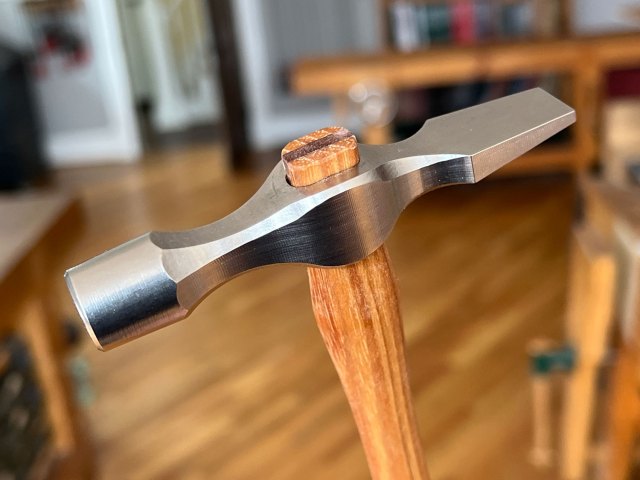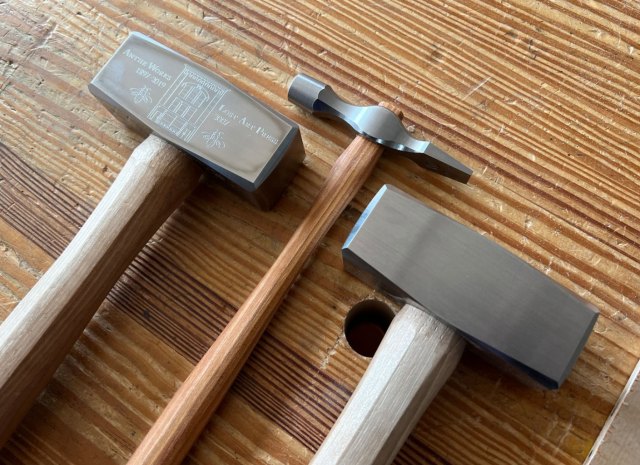
We have our first batch of Warrington hammers in stock here in Covington and ready to ship. The heads are made in Nicholasville, Kentucky. The oiled hickory handles are made in Tennessee. The hammers are hand-assembled – glued and wedged.

They are $97 each. You can place your order here. You can read all about the hammer in our stor, including what the hammer’s cross-peen is used for.
If you are coming to our open day on Saturday morning (July 29), we will have a couple dozen of the Warringtons for sale as well.
The Warrington is our second hammer. It took us a while to get to it because our lump hammer has been so damn popular (did you see that Natalie Portman uses one for climbing?). We love “lumpy” so much that we have made a special edition version that features an engraving of our new headquarters building on it. These special edition hammers are more expensive because the proceeds go to help fix up the Anthe building.

What’s next? A claw hammer. This is a project we have been building up to for a long time. We now have the design of the head complete and are working on the handle.
— Christopher Schwarz



And you just had to announce this on what is a Friday evening over here, with me on my third Duvel … What can I say? Tempting tools and beer? Hammered for hammers? A luvverly combination, I say!
Cheers (in every sense of the word),
Mattias
The photo of the claw hammer looks like you’re doing everything right. The flair at the bottom of the handle is key to reduce fatigue and a secure grip. Most current wooden handled hammers have done away with the flair making them horrible to use which is why I use vintage hammers.
I just bought a vintage maydole which unfortunatly came unhandled. I know this is tangent, but is there any information i can find about the proper measurements to create my own? I dont see the point in buying one from a modern manufacturer that will bring me the same mistakes they put in there own. Also, lipstick on a pig…
When I rehandle a vintage hammer I usually buy a handle that is designed to work with the head. That gets me something the right diameter and length. Then I modify that to suit me and the head. And if the wood sucks (as it sometimes does) then I make a copy in hickory.
Many handle suppliers offer a wide range of handles sorted by the weight of the head and the operation being performed.
So would it be safe to say that you upped the Anthe for the special edition hammers?
Will you sell me a handle? I’ve had a brass L-N cross peen hammer for years with handles that insist on breaking whenever I drop it off the bench.
I don’t know if our handle will fit the LN. Haven’t compared them. I know we will eventually sell replacement handles (once we get our supply stabilized) but I suggest, humbly, you should make your own to save some time. Handles are not difficult to make with a shave.
You can’t just drop in a line about Natalie Portman using your hammer without providing a link.
She recently ran wild with Bear Grylls.
See it here: https://www.facebook.com/watch/?v=997859124229641
so…. let me grab my beer and sit back while you tell the story of how you found out about the LAP Bear Portman banger.
Huh. I use my old climbing hammer at the workbench, so I guess there’s balance in the world.
Will you be sending any of the warrington hammers to be sold by lee valley in Canada? I do see they have the lump hammer and a few of the other tools.
Thks
K
I hope so asap, considering the LAP store sold out in hours.
Once we get a stable supply here in the U.S., we will offer it to all our suppliers.
As always, it is up to them to carry it or not.
Octagonal handle on the claw hammer, please!
What are the dimensions and weight of the hammer?
Dimensions and weights are here: https://lostartpress.com/collections/tools/products/warrington-pattern-hammer
Chris and Megan – Thanks for hosting the Q&A today. I really appreciate everything the both of you do.
Couple of questions
A project in the cue is the staked saw bench, which is one of the first projects in the design book. The book references stock 2 1/2 thick for the tops. I have some 8/4 skip planed cherry and white oak. When flattened it will be a bit thinner. I am sure that this is ok, but want to be sure. If not, do I need to glue two boards together to get the extra thickness.
Also, is there anything I should be concerned about, such as the type of leg tennon (round or conical) as the tops will be thinner than recommended in the book.
The second question is regarding the future claw hammer. Is it modeled after a particular Maydole or other mfg. model? I have always had some challenges with the claw end of my hammers when woodworking. How did you decide on the curves and length of the claws? If you can’t answer that now, all ok. I am sure you will in a later post.
Hi Fred,
You can use 8/4 as-is. It’s plenty thick enough. And the tenons can be either round or conical. I’d probably use round just because it’s faster/simpler. But it’s a good place to practice with the conical tools if you want a warm-up.
On the claw hammer, it is based on an old C. Hamilton hammer I have used for almost 20 years. The claw is rarely used in a furniture shop, so we kept the claw and slot pretty standard for a carpenter or joiner.
We use nail snips to pull nails because they are less likely to damage the casework.
Hi LAP/Crucible tool,
I’d like to buy a warrington head and make my own handle. How to go about it?
R/
William